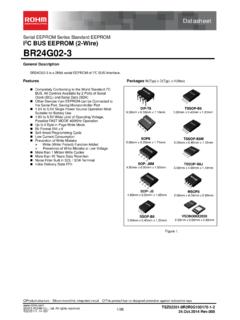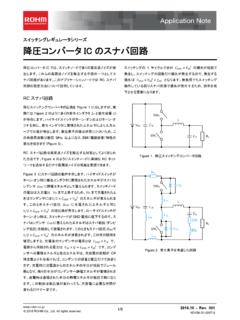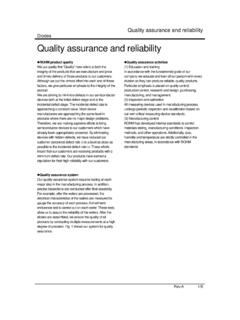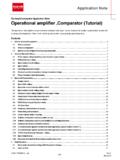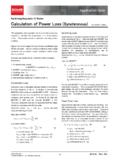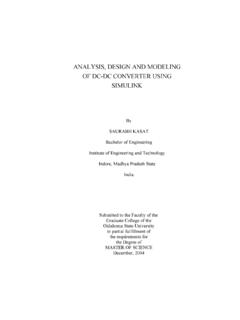Transcription of Capacitor Calculation for Buck converter IC - Rohm
1 1 of 6 - Rev. C 2014 ROHM Co., Ltd. All rights reserved. VIN CO DL RLQ1 VOUTIO ONOFFCINICINIINIDDILIDICO tONtOFFtON tOFFtON tOFF ttttttQ1 IDDIOIOIDIINILIO ILICOICINC urrent which flows at tOFFC urrent which flows at tONSwitching Regulator IC series Capacitor Calculation for buck converter IC This application note explains the Calculation of external Capacitor value for buck converter IC circuit. buck converter Figure 1 is the basic circuit of buck converter . When switching element Q1 is ON, current flows from VIN through the coil L and charges the output smoothing Capacitor Co, and the output current Io is supplied. The current which flows into the coil L at this time induces a magnetic field, and electric energy is transformed into magnetic energy and accumulated for storage. When switching element Q1 is OFF, free-wheeling diode D turns ON and energy stored in L is then released to the output side. Calculation of Input Capacitor Rated voltage of input Capacitor must be higher than the maximum input voltage.
2 Also rated ripple-current of the Capacitor must be higher than the maximum input ripple-current of the IC. Although the average value of an input current becomes smaller in proportion to the transformation ratio, momentarily the same current equal to output current flows through the buck converter as shown as IDD in Figure 2. This will be averaged by the input Capacitor , but as it is clearly shown as ICIN of Figure 2, the alternating ripple-current flowing in the input Capacitor , is higher than ICO of the output. Effective value of ICIN can be calculated by following equation: 1 [ARMS] (1) Figure 3 shows the ripple heat generation characteristics of a ceramic Capacitor (by Murata Manufacturing Co.). Whether it can be used as input Capacitor or not is decided by this graph and the absolute maximum rating of ripple-current. Be well aware of the temperature and DC bias impressed to the Capacitor when using ceramic Capacitor .
3 1 Basic buck converter circuit Figure 2 Current waveform of each part Application Note 2 of 6 Capacitor Calculation for buck converter - Rev. C 2014 ROHM Co., Ltd. All rights reserved. Change of capacitance value due to temperature can obtain stable temperature characteristic by using high permittivity ceramic Capacitor with the characteristics of X5R and X7R. Capacitance value reduces when DC bias at both sides of ceramic Capacitor increases. Figure 4 shows the DC bias characteristics (by Murata Manufacturing Co.). Input ripple voltage of regulator is decided by the value of input capacitance. Input ripple voltage VIN can be calculated by the following equation. [VP-P] (2) : Input voltage [V] : Output voltage [V] : Maximum load current [A] : Input Capacitor [F] : Switching frequency [Hz] : Maximum equivalent series resistance ESR [ ] of input Capacitor -60-50-40-30-20-100100 10203040 CAP.
4 CHANGE (%)DC BIAS (V)11010001234567 TEMPERATURE RISE ( C)CURRENT (A)fSW = Rated voltageFigure 3 Ripple heat generation characteristic Example: Characteristic of Ceramic Capacitor (make: Murata Manufacturing Co.) GRM32ER7YA106KA12 10 F 10%, 35V, X7R Figure 4 DC bias characteristic Application Note 3 of 6 Capacitor Calculation for buck converter - Rev. C 2014 ROHM Co., Ltd. All rights reserved. Calculation example of input Capacitor For this design example, parameters listed in Table1 will be used. As for the input Capacitor , Murata Manufacturing Co. make10 F / 35V ceramic Capacitor is considered for reference. Parameter Value Input voltage range VIN 7V to 28V Output voltage VOUT Input ripple voltage VIN 300mV Output ripple voltage VO 33mV (1% of output voltage) Output rating current IO 3A Inductor ripple current IL (30% of output rating current) Operation frequency fSW 1 MHz Table1 Design parameter Calculate input ripple current by substituting each parameter to the equation (1).
5 1 . 3 1 . [ARMS] (3) From Figure 3 ripple current capacitance obtains enough margins. Next, calculate input ripple voltage by substituting each parameter to equation (2). At this point consideration for DC bias characteristic of ceramic Capacitor is necessary. In this example, since the maximum voltage impressed to Capacitor is 28V, 48% will be reduced from rating capacitance value as from Figure 4. Also, ESR of ceramic Capacitor is 2m .. 3 2 10 74 [mVP-P] (4) Ripple voltage of minimum input voltage can be shown as below method.. 3 2 10 [mVP-P] (5) The design requirement for input ripple voltage below 300mV can be confirmed. Maximum voltage at both ends of input Capacitor is VIN(MAX) + VIN/2. To obtain more voltage margins, give consideration of using two F / 50V capacitors in parallel.
6 Also, be cautious for actual input ripple voltage that may get higher than the calculated value, due to output impedance of the voltage source (preceding circuit) and parasitic component resulting from the PCB layout. Application Note 4 of 6 Capacitor Calculation for buck converter - Rev. C 2014 ROHM Co., Ltd. All rights reserved. Calculation of output Capacitor Important elements in designing output Capacitor are rating voltage, ripple rating current, and ESR (equivalent series resistance). Ripple current and voltage impressed to the Capacitor must be less than the maximum rating. ESR is an important element to decide the output ripple voltage with the inductor current. The effective value of ripple current, the alternating component included in the output current, can be calculated by the following equation as it is a triangular waveform like ICO of Figure 2. [ARMS] (6) Output ripple voltage is the composite waveform created by the ripple current of the inductor flowing through the output Capacitor depending on electrostatic capacitance, ESR, and ESL.
7 It can be calculated by the following equation. [VP-P] (7) When using leaded type aluminum electrolytic Capacitor with high ESR and ESL as an output Capacitor , notice that ripple by ESR and ESL may get bigger than the ripple by capacitance. : Maximum input voltage [V] : Output voltage [V] : Inductor value [H] : Switching frequency [Hz] : Maximum input voltage [V] : Inductor ripple current [A] : Output Capacitor [F] : Inductor value [H] : Switching frequency [Hz] ESR: Equivalent series resistor of output Capacitor [ ] ESL: Equivalent series inductor of output Capacitor [H] Application Note 5 of 6 Capacitor Calculation for buck converter - Rev. C 2014 ROHM Co., Ltd. All rights reserved. Calculation example of output Capacitor For this design example, parameters listed in Table 1 will be used.
8 As for the input Capacitor , Murata Manufacturing Co. make 22 F / 25V ceramic Capacitor is considered as reference. Calculate ripple current by substituting each parameter to equation (6). Use H value for coil L.. [ARMS] (8) From Figure 5 ripple current capacitance obtains enough margin. Next, calculate output ripple voltage by substituting each parameter to equation (7). At this point consideration for DC bias characteristic of ceramic Capacitor is necessary. In this example, because the voltage impressed to Capacitor is , 2% will be reduced from rating capacitance value as in Figure 6. Also, ESR of ceramic Capacitor is 2m and ESL is . 2 10 10 . [mVP-P] (9) Output ripple voltage requirement is 33mV, meaning that the above value satisfies. But, the actual output ripple voltage can be influenced by ESR, ESL elements of Capacitor and by parasitic element originated in PCB layout, causing difference from the calculated value.
9 -90-80-70-60-50-40-30-20-100100102030 CAP. CHANGE (%)DC BIAS (V)11010001234567 TEMPERATURE RISE ( C)CURRENT (A)fSW = Rated voltageFigure 5 Ripple heat generation characteristic Figure 6 DC bias characteristic Example: Characteristic of Ceramic Capacitor (make: Murata Manufacturing Co.) GRM32ER71E226ME15 22 F 20%, 25V, X7R Application Note 6 of 6 Capacitor Calculation for buck converter - Rev. C 2014 ROHM Co., Ltd. All rights reserved. VIN CODLRL Q1 VOUT IOON OFF CIN ICIN IIN IDDILIDICO Equation of buck converter Effective value of ripple current flowing in input Capacitor 1 [ARMS] Input ripple voltage [VP-P] Effective value of ripple current flowing in output Capacitor [ARMS] Output ripple voltage [VP-P] : Input voltage [V] : Minimum input voltage [V] : Output voltage [V] : Output rating current [A] : Inductor ripple current [A] (Usually set between 20% and 50% of IO) : Maximum load current [A] : Input Capacitor [F] : Switching frequency [Hz] : Maximum equivalent series resistance (ESR) of Input Capacitor [ ] : Maximum input voltage [V] : Output voltage [V] L: Inductor value [H] : Switching frequency [Hz].
10 Inductor ripple current [A] (Usually set between 20% and 50% of IO) : Output Capacitor [F] ESR: Equivalent series resistance of output Capacitor [ ] ESL: Equivalent series inductance of output Capacitor [H] buck converter 2014 ROHM Co., Ltd. All rights Customer Support System you for your accessing to ROHM product informations. More detail product informations and catalogs are available, please contact us. Notes The information contained herein is subject to change without notice. Before you use our Products, please contact our sales representative and verify the latest specifica-tions :Although ROHM is continuously working to improve product reliability and quality, semicon-ductors can break down and malfunction due to various , in order to prevent personal injury or fire arising from failure, please take safety measures such as complying with the derating characteristics, implementing redundant and fire prevention designs, and utilizing backups and fail-safe procedures.


